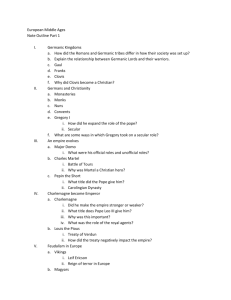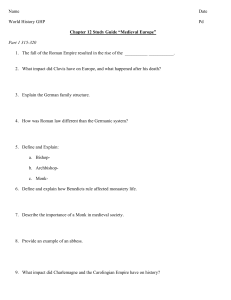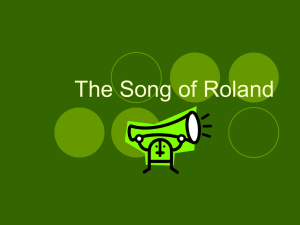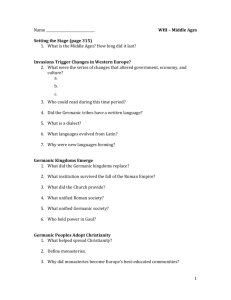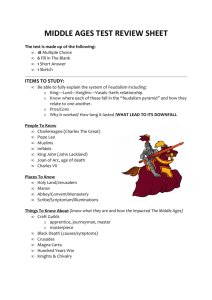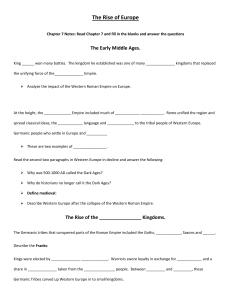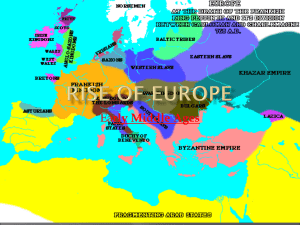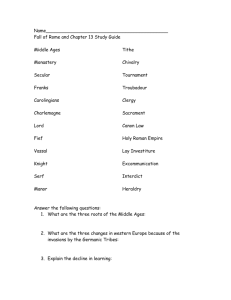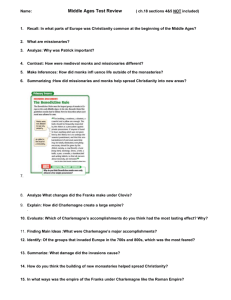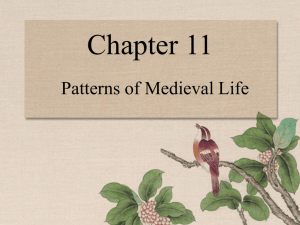Patterns of Medieval Life
advertisement
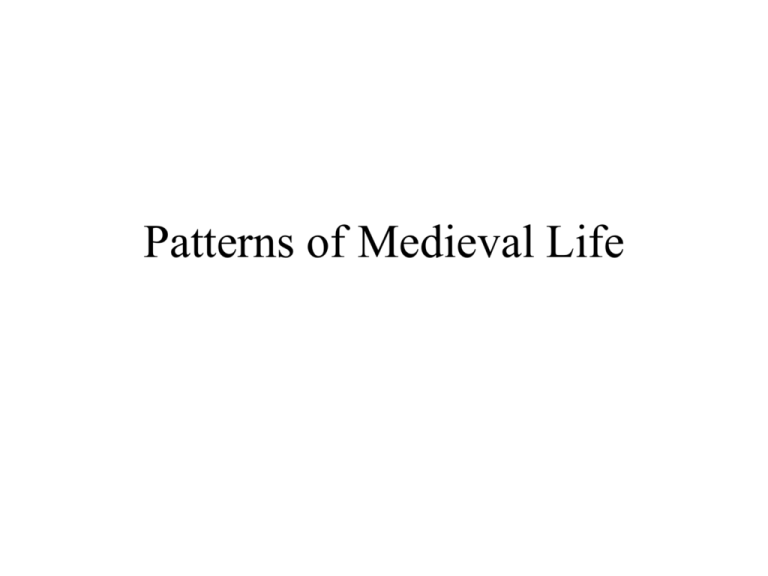
Patterns of Medieval Life Rome’s Three Heirs • Byzantine Empire • Islamic Empire • Western Christendom Middle Ages • Three cultural traditions: –Greco-Roman –Judeo-Christian –Germanic Germanic Tribes • Nomadic tribes, driven Westward by the Huns • Made unstable alliance with the Roman Empire • Visigoths raid Rome in 410, Vandals cause destruction in 455 (hence, “vandalize”) • Germanic commander Odoacer deposes Roman emperor in 476—bringing Empire to an end Germanic Culture • Not “civilized” like Greco-Roman culture – Nomadic, warrior culture – Based on chieftains – Fealty between warrior and chieftain is the basic relationship in society – Law is oral, not written – Religion: nature deities; however, many Germanic peoples convert to Christianity Beowulf • 3,000-line Anglo-Saxon epic originating c. 700, written down later (10th century) • Unrhymed verse • Kennings: two-term metaphors (e.g., “ringgiver,” “whale-path”) • Beowulf, a prince, has 3 adventures: the monster Grendel; Grendel’s mother; dragon Germanic Art • Earliest examples are portable • Later examples fuse with Christian culture – Lindisfarne Gospels, 7th-century England • Cruciform design • Combines “compositional order with a sense of labyrinthine movement” (Fiero 247) • Similarity to Islamic art: “complex rhythmically meandering surface designs” (Fiero 247) Charlemagne • Frankish king, Charles the Great, reigned 768-814 • Created a Christian Empire modeled on Roman Empire • Pope Leo III crowned him “Emperor of the Romans” in Rome in 800 Carolingian Renaissance • Charlemagne sponsored a revival in architecture, learning and literacy – Benedictines play important role – Charlemagne established schools where monks and nuns copied Latin manuscripts, religious and other • Develop miniscule writing style (see Fiero 249) – Charlemagne himself was barely literate Palatine Chapel, Aachen, Germany, 792-805 San Vitale, Ravenna, Italy, 6th c. Charlemagne (Equestrian) Marcus Aurelius Lindau Gospels, c. 800 Feudal Society • After Charlemagne, unity does not survive – Lack of administrative order and standing army – Vikings and Muslims pose threat – Empire divided among Charlemagne’s grandsons • Feudalism supplies alternative political order Knight Wearing Hauberk (c. 1200) Feudalism • Lord grants his vassal land (a fief) • In return, vassal gives lord military service • The exchange of oaths between lord and vassal was called investiture • Upper 10% of European society involved in feudal contract: nobles Feudalism • Male nobles were knights (chevalier) Chivalry was the code of behavior dictating the actions of lords and vassals. • Nobles included both men and women; female aristocrats could inherit land Song of Roland • Chanson de geste (“song of heroic deeds”) – Peformed by jongleurs: Professional entertainers • Demonstrates Roland’s loyalty to Charlemagne and the code of chivalry • Demonstrates the warfare between Christians and Muslims Norman Conquest • Vikings=Norsemen=Northmen=Normans • In 1066, William of Normandy crossed English channel and defeated Anglo-Saxon Duke Harold at Battle of Hastings. Effects: – Feudalism came to England – French words incorporated into English Bayeux Tapestry • 11th century embroidery recording William’s conquest of England • 231 feet long Halley’s Comet on Bayeux Tapestry Song of Roland & Bayeux Tapestry: Similarities • “epic in theme and robust in style” • “sweeping narratives whose episodes are irregular rather than uniform in length” • Stereotypical characters • Weapons and armor described • “heroic splendor” of feudal life (Fiero 255-56) Medieval Manor • Manorialism was the medieval economic system, just as feudalism was the political system • Lords and serfs (peasants, who equalled 90% of European population) were interdependent – Serfs needed protection; lords needed workers Effects of Crusades, 1096-1204 • “revival of trade between East and West enhanced European commercial life, encouraging the rise of towns. . . .” • Lands centralized in absence of nobles on crusades • Contact with Byzantium reestablished, opening doors to Byzantine commerce and culture (Fiero 258-59) Lancelot vs. Song of Roland • “feminization of the chivalric ideal” in Lancelot – Roland motivated by glory and fealty – Lancelot motivated by romantic love – Roland wants to be remembered by his lord; Lancelot wants to be seen by Guinevere Lancelot Crossing the Swordbridge and Guinevere in the Tower, c. 1300 Troubadours • Men and women of the nobility • Wrote and performed poems about “courtly love, chivalry, religion, and politics” (263)
